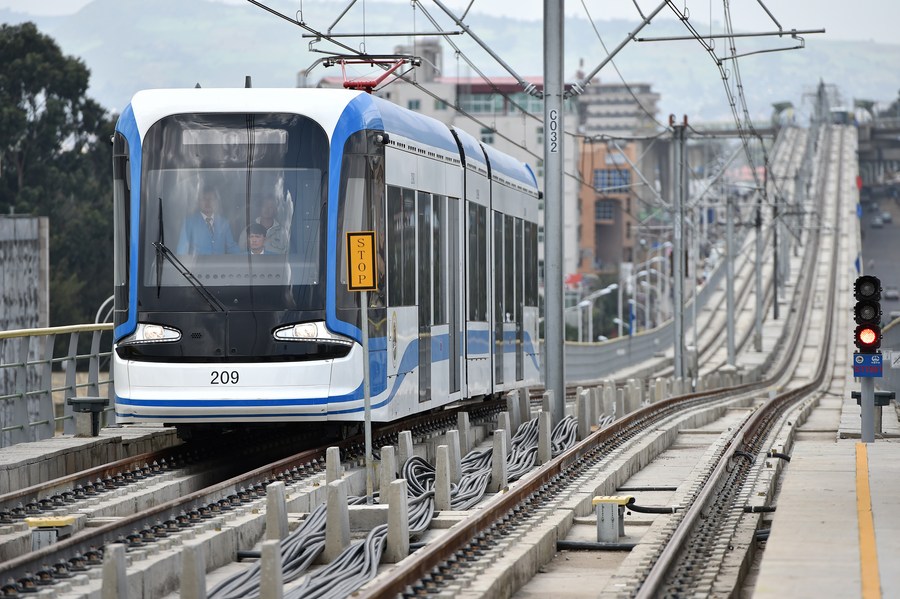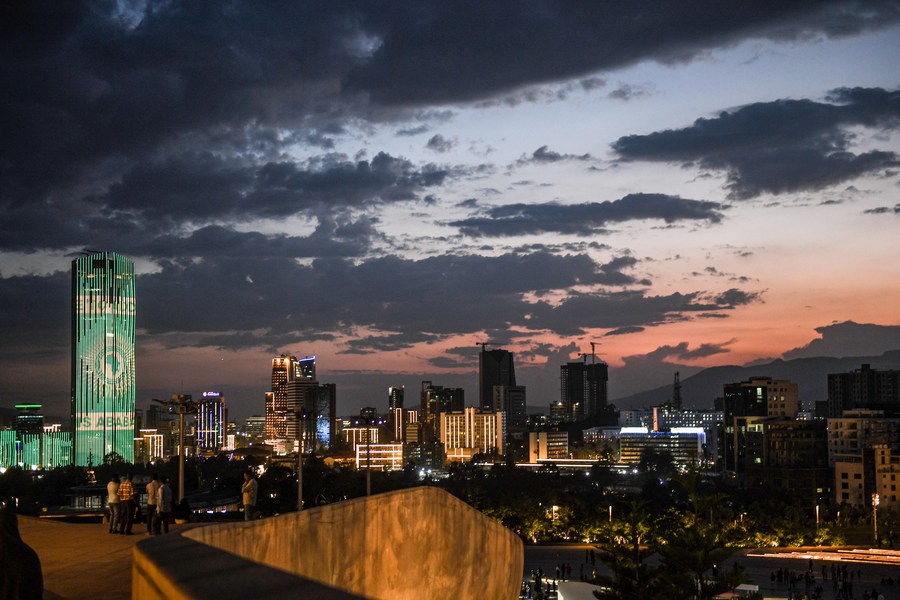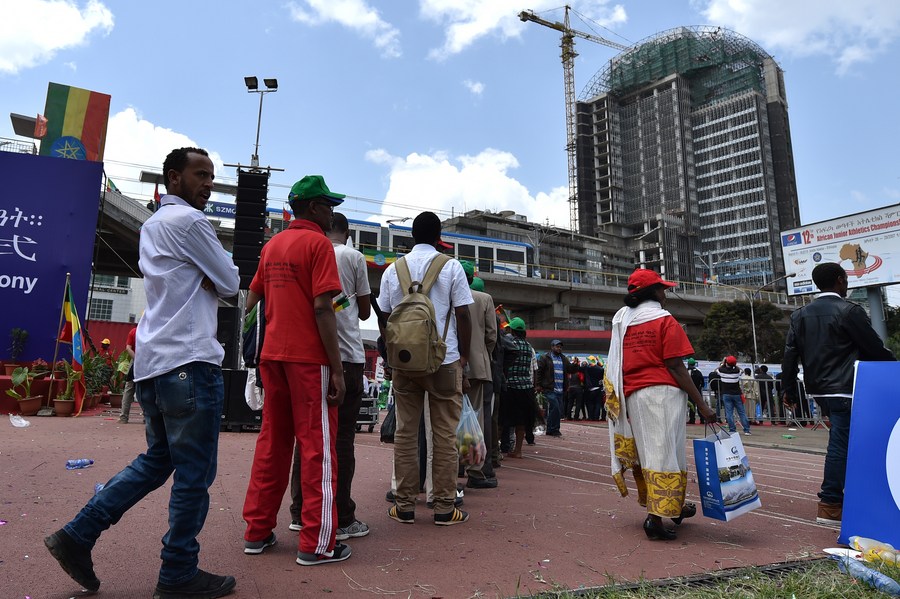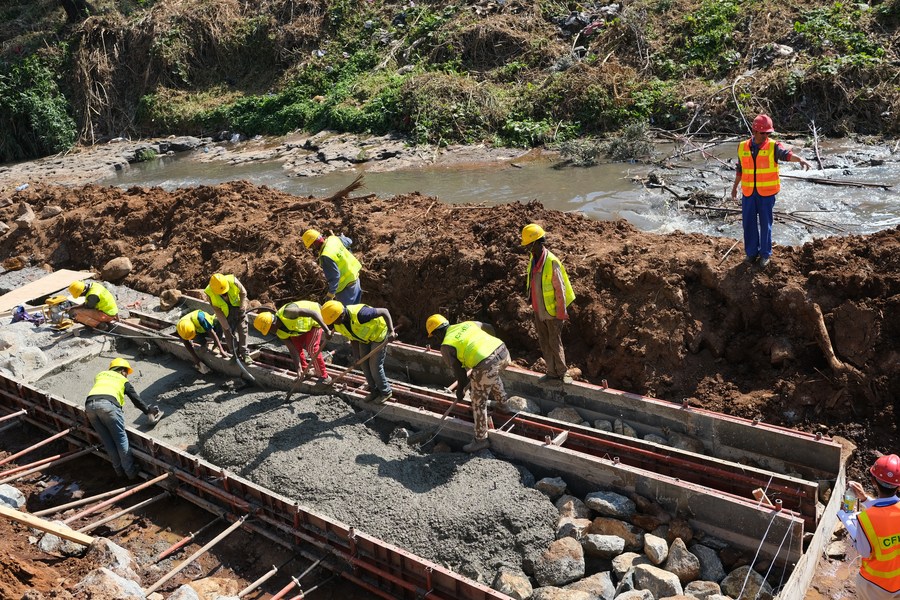Chinese-built railways win hearts of Ethiopians with greener, cheaper transportation

Photo taken on Sept. 20, 2015 shows a train operating on the light rail in Addis Ababa, Ethiopia. [Xinhua/Sun Ruibo]
Nigussie beamed with joy as he described his newfound liberation from the nightmare of traffic jams and the time-saving benefits of the Addis Ababa Light Rail Train (AALRT), which was put into operation in 2015.
ADDIS ABABA -- For the past 15 years, Natnael Nigussie has been operating a small business, selling female cosmetics and clothing, in a bustling area called Legehar at the heart of Addis Ababa, the capital of Ethiopia.
His daily routine started with a two-hour drive through the chaotic morning rush to reach his small shop from his home in the eastern suburb of the city.
Nigussie beamed with joy as he described his newfound liberation from the nightmare of traffic jams and the time-saving benefits of the Addis Ababa Light Rail Train (AALRT), which was put into operation in 2015. Hundreds of thousands of people are travelling with the light rail every day from 39 stations across the city.
"After I started commuting on the light rail, going to the city center is no longer a nightmare of traffic jams. Time is the lifeblood of my business," said the 32-year-old with a smile. "Thanks to the light rail, I spend less than half the time commuting to Legehar, where my shop is located. It has been a game-changer for me."

This photo taken on Feb. 18, 2024 shows the dusk view of Addis Ababa, Ethiopia. [Xinhua/Li Yahui]
Built by China Railway Engineering Corporation, the 34-km light railway was introduced to Addis Ababa in September 2015. The city has an estimated 5 million residents and is also home to the headquarters of the African Union and the UN Economic Commission for Africa.
Binyam Beyene, also a resident in Addis Ababa who commutes by the light rail in his daily endeavors, spoke highly of the light rail for its efficient and cost-effective transport service.
"You can imagine one has to pay several hundred (Ethiopian) birr fetching a ride or other transportation services, while the light rail only costs 20 or less birr from one corner of the city to another," he said.
Beyene also singled out the light rail's key role in championing low-carbon transportation in Ethiopia as well as its lower noise and air pollution levels.
The East African country spent 6 billion U.S. dollars on fuel imports in 2023, more than half of which went to fueling vehicles, according to the Ethiopian Ministry of Transport and Logistics. Additionally, pollution levels in city centers due to these vehicles are reportedly off the charts.

Ethiopians wait in lines before they can experience the newly opened light rail in Addis Ababa, Ethiopia, Sept. 20, 2015. [Xinhua/Sun Ruibo]
The Chinese-built light rail transit network transported more than 109 million people in the first 41 months since its operation, significantly reducing traffic congestion and pollution in the Ethiopian capital, according to China Railway Engineering Corporation.
The AALRT is one of a number of mega infrastructure development projects realized by Ethiopia in recent years in partnership with China.
The Ethiopia-Djibouti Standard Gauge Railway is another Chinese-built flagship transportation project, representing the socioeconomic importance of Chinese engagements in one of Africa's fastest-growing economies.
With about 126.5 million people as of 2023, Ethiopia is the second most populous nation in Africa after Nigeria, and one of the fastest-growing economies in the region, with an estimated 7.2 percent growth in the 2022/2023 fiscal year, according to the World Bank.
The 752.7-km Ethiopia-Djibouti railway, as one of the early harvests of Ethiopia's cooperation with China under the China-proposed Belt and Road Initiative (BRI), has won plaudits for its strong contribution to Ethiopia's development.
Data from the Ethiopia-Djibouti Standard Gauge Railway Share Company show that the railway earned 2.84 billion birr (about 50 million U.S. dollars) in the first nine months of the current Ethiopian fiscal year 2023/2024, which started on July 8, 2023. The revenue generated is up by about 1.12 million U.S. dollars compared to the same period last year.
The flagship electrified railway was able to transport 148,664 passengers during the same period, an increase of 15 percentage points year on year.
Experts echoed the assertion, highlighting the contribution of the AALRT and other Chinese-built flagship infrastructure projects in improving transportation in Ethiopia.
Costantinos Bt. Costantinos, a professor of public policy at the Addis Ababa University in Ethiopia, told Xinhua in a recent interview that while Ethiopia has suffered from conflicts and catastrophic droughts, its economic development and infrastructure coverage have seen "an overwhelming transformation under the BRI and the Forum on China-Africa Cooperation."
"As part of the BRI and bilateral accords, avant-garde development has been taking place in Ethiopia that generates investment and improvement of people's lives such as a 20-year increase in life expectancy, over a hundred thousand kilometers of roads, and about a thousand kilometers of railways," he said.
"In the spirit of multilateralism and genuine stride to uplift humanity, China has taken steps to fill this colossal void in building Africa's agricultural and manufacturing infrastructures," Costantinos said.

This photo taken on Oct. 27, 2019 shows the construction site of the Friendship Square in Addis Ababa, Ethiopia. [China First Highway Engineering Co., Ltd./Handout via Xinhua]
According to Melaku Mulualem, a senior international relations and diplomacy researcher at Ethiopia's Institute of Foreign Affairs, the two railway projects, along with other development projects such as the construction of a dozen industrial parks in different regions of Ethiopia, vividly manifest the success of Sino-Ethiopian infrastructure development cooperation under the BRI.
"The BRI has improved the lives of many Ethiopians. Many Ethiopians are working on various BRI projects, including industrial parks, railway stations, highway and expressway constructions, digital networking sectors, and many others. These projects are also hugely contributing to our economy," said Mulualem.
However, in order to maximize the performance and benefits of these infrastructures, experts also called upon relevant parties to set aside adequate funding to build local maintenance facilities and store enough spare parts for repair. Human capital should also be well-trained and paid to ensure the sustainable running of these railways.
























